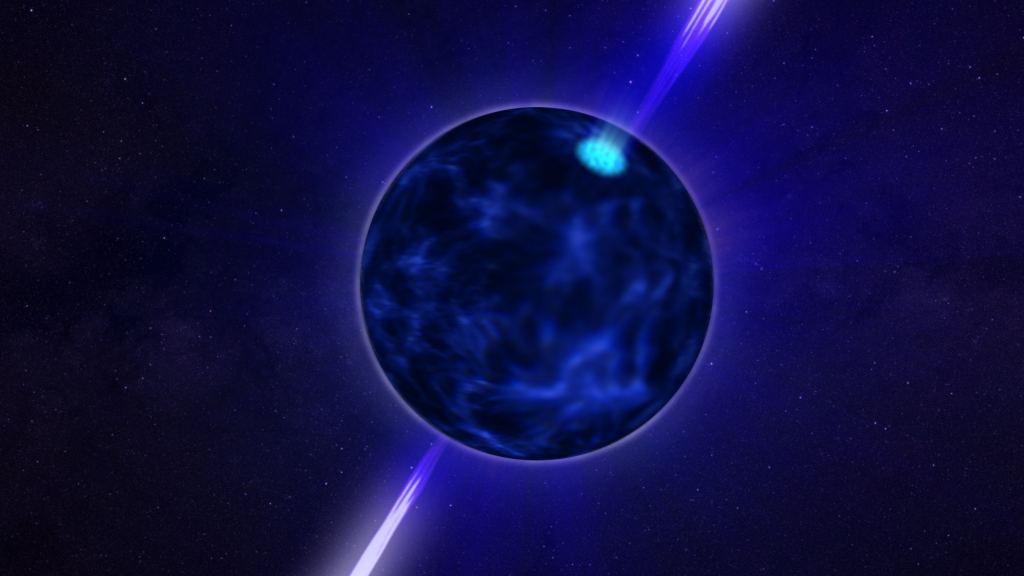In June 2008, the Gamma-ray Large Area Space Telescope began surveying the cosmos to study some of the most energetic phenomena in the Universe. Shortly after that, NASA renamed the observatory in the Fermi Gamma-ray Space Telescope in honor of Professor Enrico Fermi (1901-1954), a pioneer in high-energy physics. During its mission, Fermi has addressed questions regarding some of the most mysterious and energetic phenomena in the Universe – like gamma-ray bursts (GRBs), cosmic rays, and extremely dense stellar remnants like pulsars.
Since it began operations, Fermi has discovered more than 300 gamma-ray pulsars, which have provided new insights into the life cycle of stars, our galaxy, and the nature of the Universe. This week, a new catalog compiled by an international team contains the more than 300 pulsars discovered by the Fermi mission – which includes 294 confirmed gamma-ray-emitting pulsars and another 34 candidates awaiting confirmation. This is 27 times the number of pulsars known to astronomers before the Fermi mission launched in 2008.
The international team is made up of 170 scientists from institutions across the globe, including the French National Center for Scientific Research (CNRS), the Netherlands Institute for Radio Astronomy (ASTRON), the Istituto Nazionale di Fisica Nucleare (INFN), the Kavli Institute for Particle Astrophysics and Cosmology , the National Institute for Astrophysics (INAF), the South African Radio Astronomy Observatory (SARAO), the Italian Space Agency (ASI), the Max Planck Institute for Gravitational Physics and Radio Astronomy (MPIFR), the ARC Centre of Excellence for Gravitational Wave Discovery (OzGrav), NASA’s Goddard Space Flight Center, and more. The catalog, “ The Third Fermi Large Area Telescope Catalog of Gamma-Ray Pulsars ,” appeared on Monday, Nov. 27th, in The Astrophysical Journal Supplement.
Pulsars are a type of neutron star, which are what remains when stars undergo gravitational collapse near the end of their lives and go supernova. These and other neutron stars are the densest objects that astronomers can study directly (as opposed to black holes, which can only be studied indirectly). Pulsars are so-named because they possess strong magnetic fields that force their radiation into narrow beams emitted from their poles.
Combined with how they spin rapidly on their axis, this produces a lighthouse-like effect that astronomers can detect light-years away. A dozen radio telescopes worldwide monitor thousands of pulsars regularly, and astronomers are constantly looking for new candidates within gamma-ray sources discovered by Fermi. Of the 3,400 known pulsars, most were detected via radio waves and located within our Milky Way galaxy.
Only about 10% of pulsars also emit gamma rays, while others have been identified that emit gamma rays but not radio emissions. David Smith, research director at the Bordeaux Astrophysics Laboratory in Gironde (part of CNRS), was the study coordinator. As he explained in a NASA press release : “Pulsars touch on a wide range of astrophysics research, from cosmic rays and stellar evolution to the search for gravitational waves and dark matter.
This new catalog compiles full information on all known gamma-ray pulsars in an effort to promote new avenues of exploration. ” As Smith and his colleagues indicate in the catalog, fewer than a dozen gamma-ray pulsars were known when Fermi launched in 2008. Moreover, the extent and diversity of the population and its role in Galactic dynamics were subject to debate.
But thanks to the mission and its primary instrument, the Large Area Telescope (LAT), scientists quickly learned that the gamma-ray population is large and varied and that these pulsars are the dominant gamma-ray source in the billion-electronvolt (GeV) class in the Milky Way. Fermi also detected the first gamma-ray pulsar beyond the Milky Way in 2015, located in the neighboring Large Magellanic Cloud (LMC). This effectively demonstrated that flares from supermagnetized neutron stars can be detected in distant galaxies.
In addition, its measurements have provided important limits on new theories of gravity and the nature of Dark Matter. They also revealed a previously-unknown component in our galaxy known as the Fermi Bubbles , a structure spanning 50,000 light-years that is likely the result of radiation outbursts from the supermassive black hole (SMBH) at the center of our galaxy ( Sagitarrius A* ). The First FERMI LAT Catalog (LAT-1), released in 2010, contained 46 pulsars based on six months of data.
The second catalog , based on the first three years of data, grew that number to 132. This third installment is based on 12 years of data that characterizes the 294 confirmed gamma-ray pulsars and 33 millisecond pulsars (MSPs), which have not yet shown gamma-ray pulsations but likely will once accurate rotation ephemerides are established. Before Fermi, astronomers did not know if MSPs were visible at high energies, but these now account for about half of the overall catalog.
“More than 15 years after its launch, Fermi remains an incredible discovery machine, and pulsars and their neutron star kin are leading the way,” said Elizabeth Hays, the mission’s project scientist at NASA’s Goddard Space Flight Center. And be sure to check out the pulsar catalog on WorldWide Telescope . Further Reading: NASA.
From: universetoday
URL: https://www.universetoday.com/164518/fermi-has-found-more-than-300-gamma-ray-pulsars/



